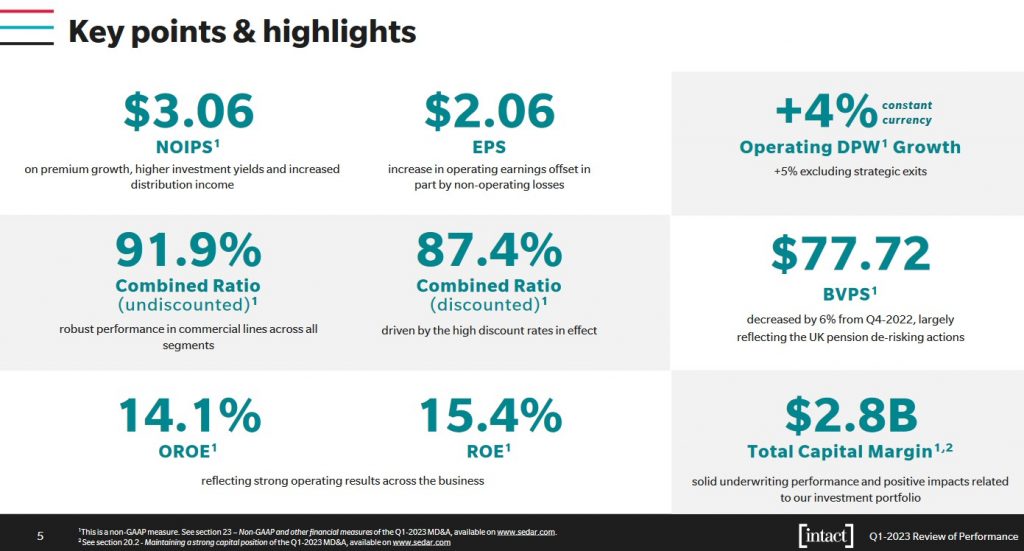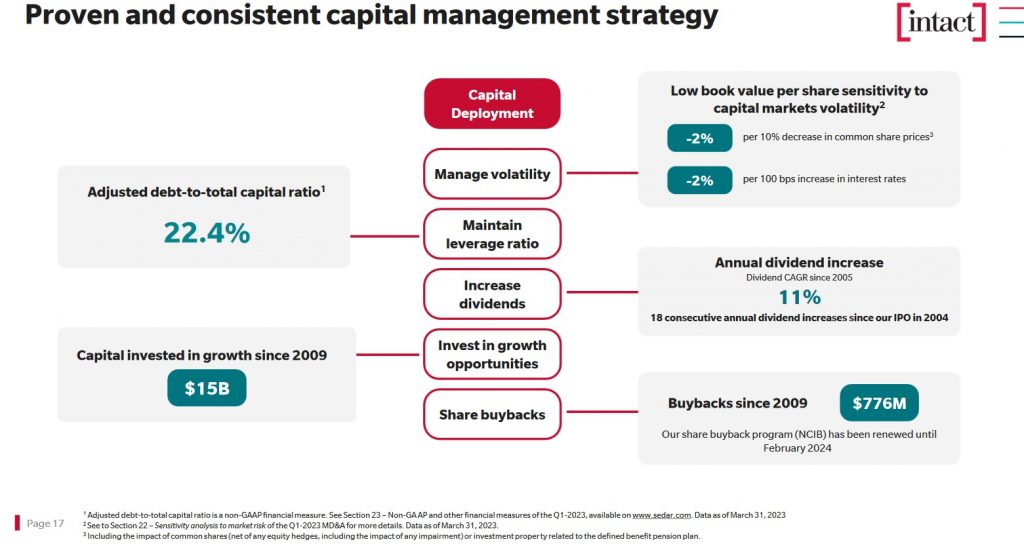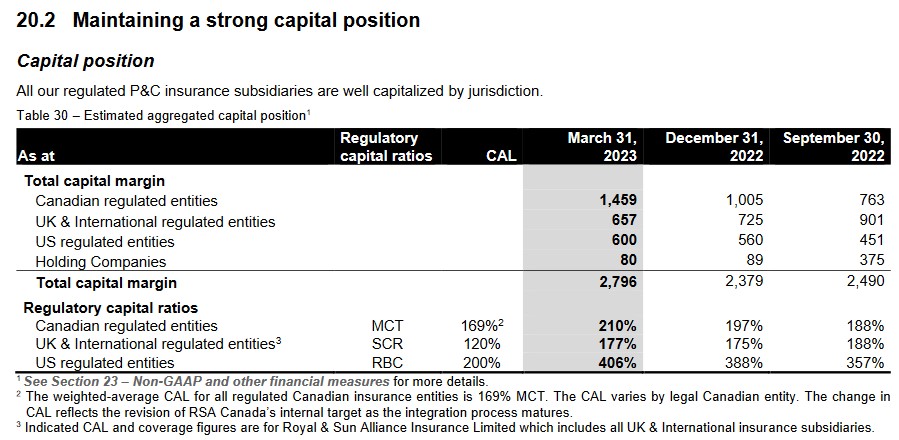Contents
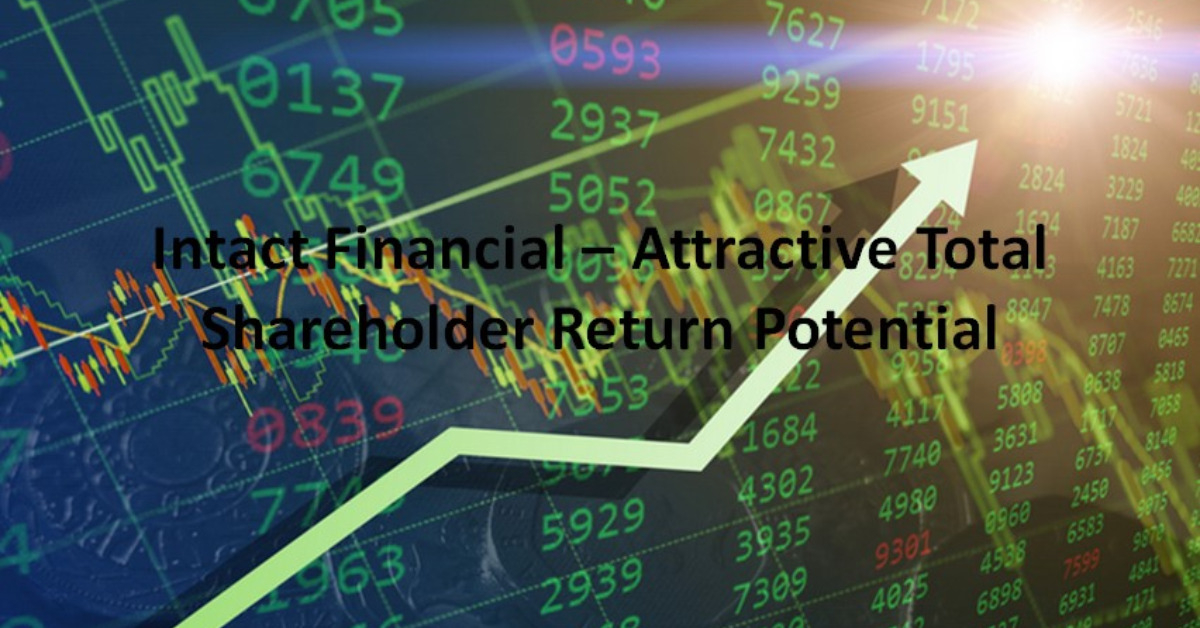
Intact Financial (IFC.to) has attractive Total Shareholder Return (TSR) potential; it generated a ~14% Total Shareholder Return (TSR) from 2012 - 2022. While past results have no bearing on future results, IFC is a well-managed insurance company which leads me to believe it has a reasonable probability of generating a comparable return over the next decade.
I last reviewed IFC in this August 1, 2022 post. At the time, the most current financial information was for Q2 2022. We now have financial information for Q1 2023 (issued on May 11).
Note: IFC reports its results in Canadian dollars.
Business Overview
IFC is the largest provider of Property & Casualty insurance in Canada, a leading specialty lines insurer with international expertise and a leader in personal and commercial lines in the U.K. and Ireland.
Its business has grown organically and through acquisitions. In FY2022 it generated $22.655B in 'Direct premiums written' and $21.053B in 'Operating direct premiums written (Operating DPW)'. In contrast, it generated ~$7.07B in Operating DPW in FY2012.
The insurance industry employs the use of several terms with which some investors may not be familiar. Fortunately, IFC provides a fairly comprehensive Glossary of insurance terms.
IFC's FY2022 Annual Report provides a good overview of the company. Further information, including the company's history, is found on the company's website.
The most recent Investor Presentation (Q1 2023 at the time this post is composed) also provides a wealth of information.
The following provides a snapshot of IFC's consolidated performance over the 2018 - 2022 timeframe.
Financial Results
Q1 2023 Results
While IFC's key points and highlights are reflected below, I encourage you to review the Q1 2023 materials which are accessible here.
Looking at page 5 of 30 in IFC's Supplementary Financial Information document, we see that its adjusted debt to total capital ratio increased following the RSA acquisition. IFC communicated it planned to reduce this to 20% within 36 months of closing the acquisition; the acquisition closed on June 1, 2021.
Management states the integration of RSA is progressing well and value creation from this acquisition has exceeded expectations to date. IFC remains on track to realize at least $0.35B of pre-tax annual run-rate synergies within 3 years.
On August 1, 2022, IFC completed the acquisition of Highland Insurance Solutions, the U.S. construction division of Tokio Marine Highland (TMH), from Tokio Marine Kiln (TMK).
In Q1 2023, Highland contributed to the 15% growth on a constant currency basis in IFC's US Commercial premiums. The US business reported a strong 89.1% combined ratio but it was 2.3 points higher than the prior year due to a large fire-related catastrophe loss and unfavourable weather.
Capital Management
The following image reflects IFC's capital deployment priorities.
Underwriting Ratios
The Operating Combined Ratio (OCR), consists of 2 components:
- claims ratio
- expense ratio
The OCR is typically expressed as a percentage. It is a measure of profitability used by an insurance company to gauge how well it is performing in its daily operations. Many insurance companies believe that the combined ratio is the best way to measure success because it does not include investment income. It only includes profit earned through efficient management. This ratio is calculated by taking the sum of incurred losses and expenses and then dividing them by the earned premium.
NOTE: The combined ratio is typically expressed as a percentage. A ratio below 100% indicates the company is making an underwriting profit. A ratio above 100% means that the insurance company is paying out more money in claims than it is receiving from premiums. However, even if the combined ratio is above 100%, a company can potentially still be profitable because the ratio does not include investment income.
IFC's OCR in FY2017 - FY2022 is 94.3%, 95.1%, 95.4%, 89.1%, 88.8%, and 91.6%. Its OCR was 88.9% in Q1 2022 and 87.4% in Q1 2023.
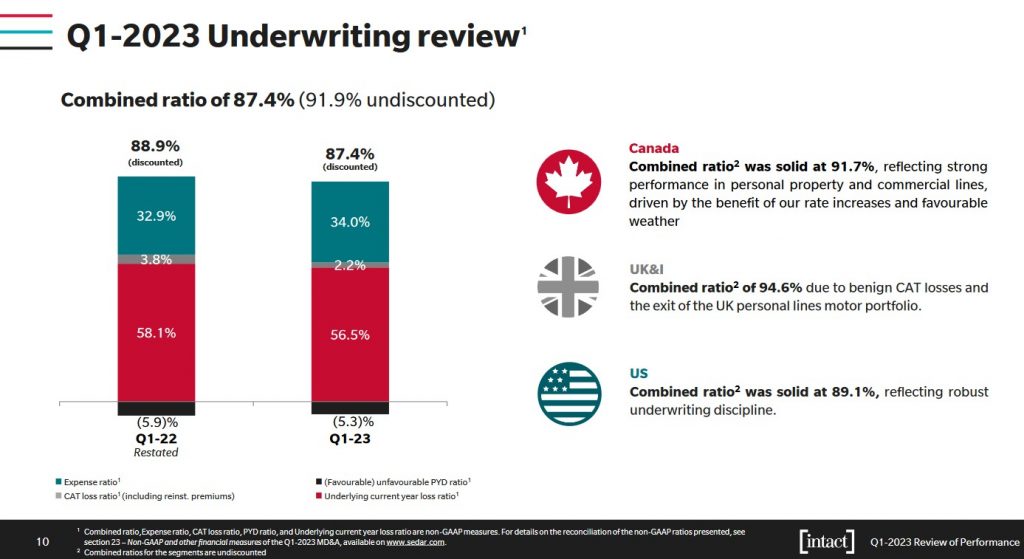
Source: IFC - Q1 2023 Earnings Presentation - May 11, 2023
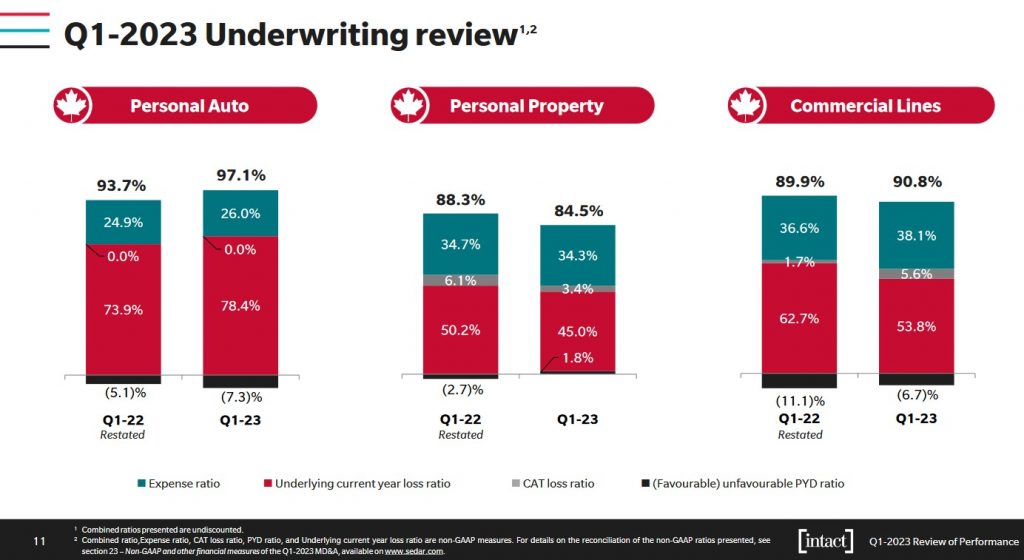
Source: IFC - Q1 2023 Earnings Presentation - May 11, 2023

Source: IFC - Q1 2023 Earnings Presentation - May 11, 2023
Capital Structure
IFC has a proven and consistent capital management strategy. Its target capital structure is:
- 70% equity;
- 20% debt excluding hybrid debt; and
- 10% preferred shares and hybrid debt.
Further details are found in section 20.3 (Managing Leverage) on page 47 of 76 in Management’s Discussion and Analysis for Q1 2023.
IFC classifies hybrids with preferred shares since they are convertible to preferred shares pari passu to its existing preferred shares in case of default or bankruptcy and include an interest payment deferral option, whereby payments can be delayed for a period of up to 5 consecutive years.
At the end of Q1 2023 (FYE2022 percentages are in brackets), IFC's capital structure consisted of:
- 67% equity (~69%);
- 22% debt excluding hybrid debt (~21%); and
- 11% preferred shares and hybrid debt (~10%).
Looking at IFC's senior and subordinated debt we see the maturity dates are well staggered.
Maintaining a strong capital position is a key priority. Looking at the capital ratios at the end of Q1 2023 we see that IFC's levels are well above its Company action levels (CALs). The CALs are thresholds below which regulator notification is required together with a company action plan to restore capital levels. The average CAL for all regulated Canadian insurance entities is 169% MCT. The CAT varies by legal Canadian entities. The CAL is 200% RBC for regulated insurance entities in the US and 120% SCR for those in the UK & Ireland.
- MCT - Minimum capital test (Canada)
- SCR - Solvency Capital Requirement (Europe)
- RBC - Risk-based capital (US)
Credit Ratings
IFC's credit ratings are accessible here.
While we see multiple ratings, I focus on the senior unsecured debt ratings assigned to Intact Financial Corporation because this is the publicly-traded company in which I hold shares.
The assigned ratings differ slightly but all are investment grade.
- DBRS's rating is the middle tier of the upper-medium grade investment-grade category.
- A. M. Best's and Fitch's rating is the bottom tier of the upper-medium grade investment-grade category.
- Moody's rating is the top tier of the lower-medium grade investment-grade category.
DBRS, A. M. Best, and Fitch define IFC as having a STRONG capacity to meet its financial commitments. Moody's rating defines IFC as having an ADEQUATE capacity to meet its financial commitments.
Despite the slight variance in ratings, all ratings are acceptable for my conservative nature.
Dividend and Dividend Yield
In February 2023, IFC declared a 10% increase in its quarterly $1/share dividend to $1.10 effective with the dividend paid on March 31, 2023. This increase marked the 18th consecutive year in which IFC increased its dividend.
The 2nd quarterly $1.10/share dividend is to be distributed on June 30 to shareholders of record on June 15.
In my prior post, I wrote:
'The 3rd $1.00/share quarterly dividend distribution is scheduled for September 30, 2022. Based on the current $190.60 share price, the dividend yield is ~2.1%. When I wrote my prior review in February, IFC had announced an increase in its quarterly dividend from $0.91/share to $1.00/share. With shares trading at ~$185, the forward dividend yield was ~2.16%.'
Using my recent $198 purchase price, the $1.10 quarterly dividend yields 2.22%.
IFC's weighted-average number of common shares outstanding in FY2011 - FY2022 (in millions) is 115, 131, 132, 132, 132, 131, 133.1, 139.2, 139.5, 143, 162.4 and 175.6.
The surge in the weighted-average number of common shares outstanding is attributed to the issuance of shares on June 1, 2021, concurrent with the closing of the RSA acquisition (refer to page 210 of the FY2022 Annual Report).
On February 17, 2022, IFC commenced a Normal Course Issuer Bid (NCIB) to repurchase, for cancellation, up to 5,282,458 common shares during the next 12 months. This represented ~3% of the issued and outstanding common shares.
On February 7, 2023, IFC's Board authorized the renewal of the NCIB for the repurchase of up to 3% of the issued and outstanding common shares over the subsequent 12-month period, subject to TSX approval.
Despite the NCIB, share repurchases are a low priority from a capital deployment perspective.
Valuation
IFC's PE in FY2011 - FY2022 is 15.86, 14.96, 18.50, 16.64, 16.86, 23.10, 19.41, 20.97, 27.43, 24.00, 14.93, and 12.87.
When I analyzed IFC's FY2021 results, it had generated $12.40 in diluted EPS and the share price at the time was ~$185 thus giving us a diluted PE of ~15.
I purchased shares at $165.82 on November 8, 2021. By the time I wrote my November 11 post, the share price had risen to $170. Using the forward-adjusted diluted EPS guidance from the brokers which cover IFC and my purchase price, the forward-adjusted diluted PE levels were:
- FY2021 - 14 brokers - mean of $10.78 and low/high of $9.45 - $11.95. The forward adjusted diluted PE was ~15.4.
- FY2022 - 14 brokers - mean of $10.98 and low/high of $9.48 - $12.23. The forward adjusted diluted PE is ~15.1.
- FY2023 - 9 brokers - mean of $12.28 and low/high of $10.21 - $13.03. The forward adjusted diluted PE is ~13.5.
I did not record the guidance from the brokers when I acquired additional shares at $162.59 on January 10, 2022. I imagine the guidance was not that much different from early November so the forward-adjusted diluted PE levels were probably fairly similar.
When I reviewed IFC on February 10, 2022, shares were trading at ~$185. Using the forward adjusted diluted EPS estimates reflected on the 2 online brokerage platforms I use, IFC's valuation was:
- FY2022 - 13 brokers - mean of $11.27 and low/high of $10.33 - $12.11. The forward adjusted diluted PE is ~16.4.
- FY2023 - 13 brokers - mean of $12.28 and low/high of $10.53 - $13.33. The forward adjusted diluted PE is ~15.
Only 1 broker had provided an estimate for 2024; this estimate was $12.85.
At the time of my August 1, 2022 post, IFC shares were trading at $190.60. Using current broker estimates, IFC's forward adjusted diluted PE levels were:
- FY2022 - 15 brokers - mean of $11.71 and low/high of $11.15 - $12.50. The forward adjusted diluted PE was ~16.3.
- FY2023 - 15 brokers - mean of $12.87 and low/high of $11.03 - $13.81. The forward adjusted diluted PE is ~14.8.
- FY2024 - 6 brokers - mean of $13.86 and low/high of $12.06 - $15.41. The forward adjusted diluted PE is ~13.8.
I have now acquired additional shares @ ~$198. Using current broker estimates, IFC's forward adjusted diluted PE levels are:
- FY2023 - 13 brokers - mean of $13.07 and low/high of $11.76 - $13.76. The forward adjusted diluted PE is ~15.2 based on the mean estimate.
- FY2024 - 15 brokers - mean of $13.84 and low/high of $12.92 - $14.65. The forward adjusted diluted PE is ~14.3 based on the mean estimate.
Final Thoughts
On June 1, I purchased 50 shares @ ~$198 in one of the 'Core' accounts within the FFJ Portfolio. This brings my IFC exposure in that account to 311 shares. In addition, I hold 204 IFC shares in another 'Core' account within the FFJ Portfolio; my total IFC exposure is 515 shares. Despite this recent purchase, IFC is not a top 30 holding.
IFC is unlikely to generate long-term total investment returns like those I anticipate from some of my other holdings (eg. Mastercard (MA), Copart (CPRT), Thermo Fisher Scientific (TMO), Danaher (DHR), Intuitive Surgical (ISRG), and HEICO (HEI-a)). Nevertheless, I think there is a good possibility it can generate an attractive total shareholder return (TSR) over the next 10 years.
I am currently satisfied with my IFC exposure and have no immediate plans to acquire more shares other than through the automatic reinvestment of dividends.
I wish you much success on your journey to financial freedom!
Note: Please send any feedback, corrections, or questions to [email protected].
Disclosure: I am long IFC.
Disclaimer: I do not know your circumstances and do not provide individualized advice or recommendations. I encourage you to make investment decisions by conducting your own research and due diligence. Consult your financial advisor about your specific situation.
I wrote this article myself and it expresses my own opinions. I do not receive compensation for it and have no business relationship with any company mentioned in this article.



